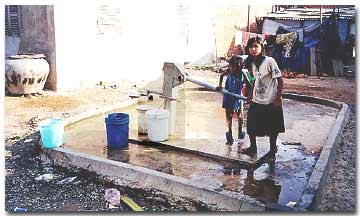|
Peri-urban communities are the last to receive services from water and sanitation utilities. Still, as in all types of communities, their residents must every day find water for drinking, cooking, washing, and bathing, and must choose where to defecate and urinate. Even where piped water and sewerage networks do reach into poor neighborhoods, home connections are often unaffordable. Municipality-operated public standpipes, public toilet facilities, and public baths are usually poorly maintained if not out of service entirely. When such facilities are privately owned and operated, however, they must be clean and affordable to attract customers and bring in a profit. It is not surprising, therefore, that the majority of peri-urban residents buy water and sanitation services from small private providers who deliver what public providers are unable or unwilling to provide.
Empirical evidence suggests two good reasons to support small providers:
1- Small providers offer huge savings in extending service coverage. Community-built sewerage systems cost only one-half to one-third as much as systems built governments, and there may be similar savings to be had by formally involving small providers in the construction and maintenance phases of secondary and tertiary networks.
2 - There will always be gaps in service provision until poverty recedes.
Categories of providers
1 - Providers in permanent partnership with water utilities, whose water they distribute at kiosks or standpipes.
2 - Pioneers who bring piped water from their own sources to communities where water utilities have not yet expanded their networks.
3 - Pioneers who build their own tertiary and secondary sewerage systems and get them connected to the sewer company’s mains.
4 - Mobile water truckers, carters and water carriers who provide water (mostly drawn from water company taps) at times and places that water utilities are unable to serve.
5 - Owner/operator/franchisers of public toilet and bathing facilities.
6 - Community-managed latrines and community-managed water system.
Pricing of services
High price:
Water truckers, carters and carriers command the highest price by volume, and can also provide the most tailored service because they have a choice of water sources and are mobile. These are the providers who serve the peak demand niches - people with little time for water collection or who, for other reasons, are willing to pay more at certain times.
Medium price:
Standpipes and kiosks are the next most expensive source and the ones which supply the greatest volume in areas where well water is of poor quality or too expensive.
Low price:
The least expensive water on a volumetric basis is provided by a home connection, especially when tariffs have not been raised to cover capital costs, as is often the case for African utility companies. On the other hand, the hookup charge required for a home connection, the lack of financing for it, and the infrequency of billing by the African water utilities all exclude the very poor from benefitting from this low volumetric charge in Africa. In contrast, the aguatero entrepreneurs of Latin America offer hookups on an installment plan and get their money by threatening disconnection followed by a hefty reconnection fee.
Cheapest price:
The least expensive water, whether offered by small providers or taken by women and children for free, comes from the natural sources such as rivers and streams but is usually of lower quality that treated, piped water or in some cases becomes increasingly distant due to hillsides erosion. Such low-cost sources, where available, are usually preferred for washing and bathing and can be used by construction entrepreneurs building on the urban periphery.
Factors of success
The main factors which emerge as important to the success of these providers are:
• an entrepreneurial or commercial approach to competition, and innovation to develop effective service or specialized customer relations;
• the multiple and indispensable roles played by community-based organizations;
• technical innovation matters - from better and cheaper toilet designs, manhole covers, and water storage tanks to new low-cost purification technology;
• investing in raising the awareness of the health benefits stemming from use of toilets rather than open defecation;
• the ease of independent water production resulting from drilling of wells or purification of natural sources; and
• the ability to offer installment plans for payment of hookup fees (removing a significant barrier to entry by new customers).
Constraints to expansion
The main constraints to the expansion of service by small-scale providers are:
• lack of access to credit for capital investment (well drilling, purchase of water tanks and pipes);
• the need for transparent procedures for handling money and ensuring accountability;
• problems with robbery and ‘pirate’ connections;
• security in the face of either unfair competition from public (subsidized) providers or outright confiscation.
And some things are not constraints:
• Cost recovery is not an issue: providers know that people will pay for water and sanitation.
• Negative public policy environment is not an issue as long as the provider sticks to its small area, even if the water company technically has a monopoly. Few will bother the provider who is operating on a small scale, something which the water company is unwilling or unable to do. Only when the scaling-up stage is reached public policy can become a constraint.
Growing pains
Except where small provider networks remain self-contained and isolated, scaling-up means meeting the network connectivity issue head-on. Negotiating this interface means looking at setting technical standards and making choices about moving small providers into a more formal legal status.
Some Issues:
• How can you plan for small providers in projects?
• How can you encourage small providers to provide services in a program?
• If small providers are so cost effective and provide quality service, what is the role of the public monopoly?
|

